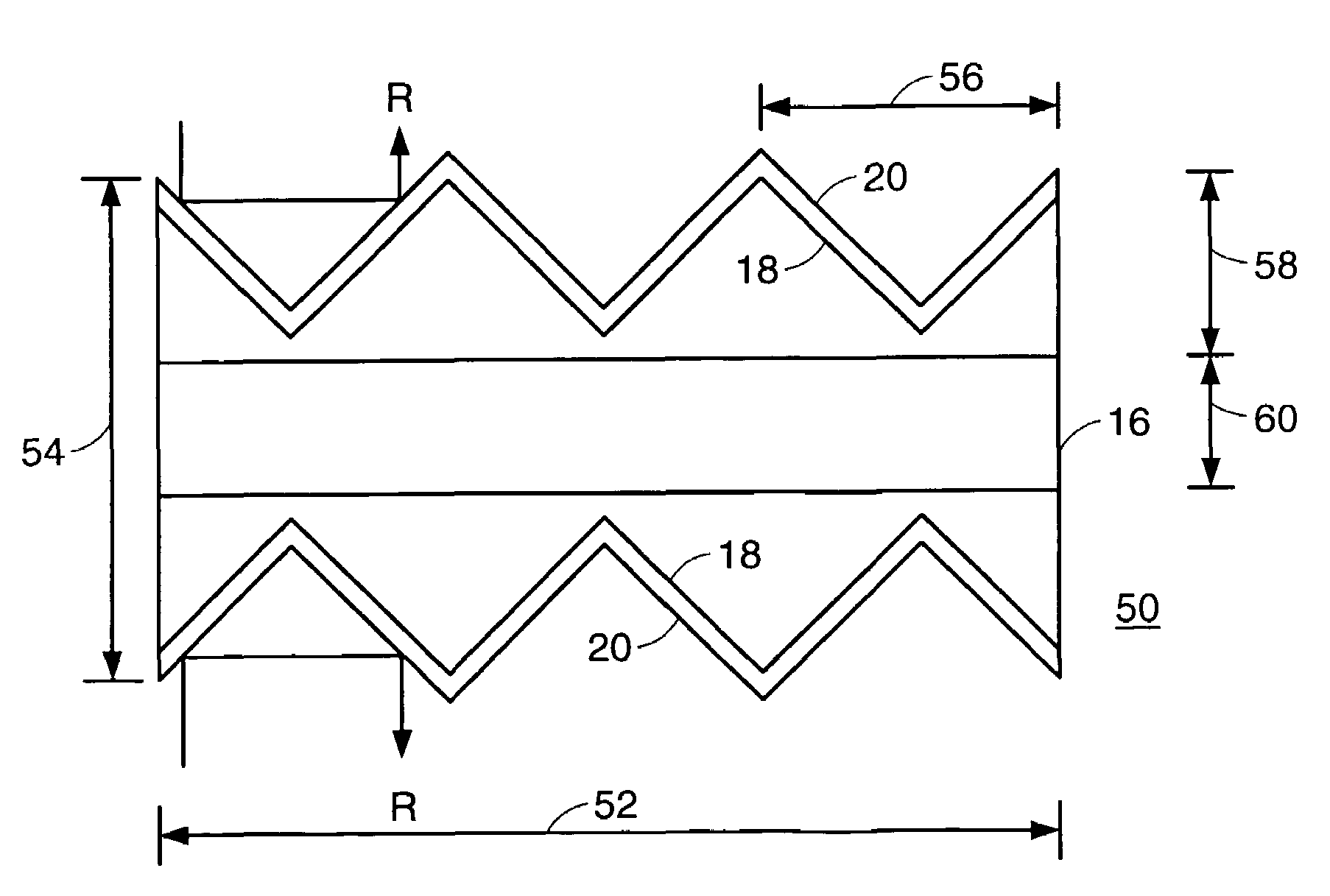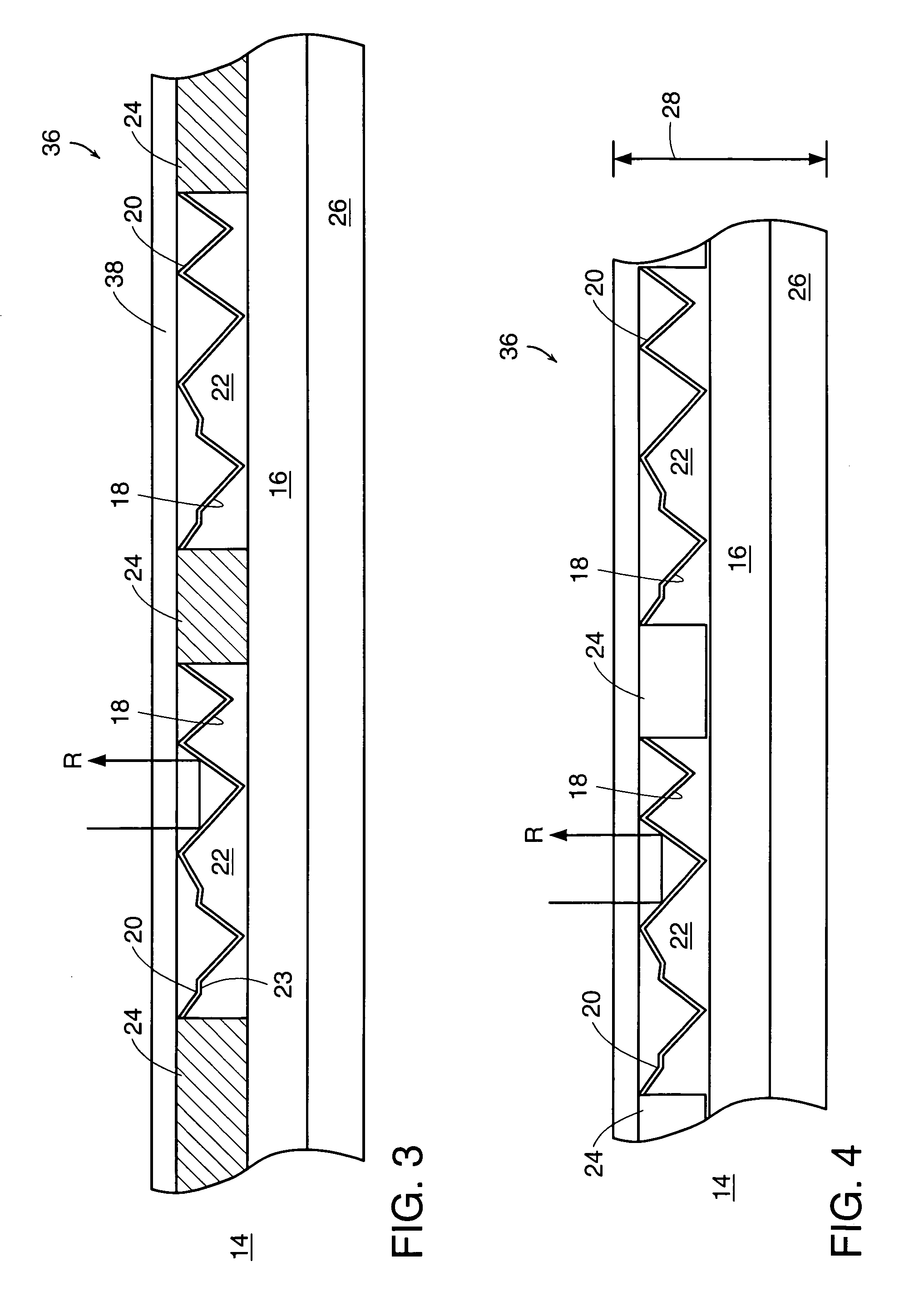Durable, open-faced retroreflective prismatic construction
a prismatic and retroreflective technology, applied in the field of durable, open-faced retroreflective prismatic construction, can solve the problems of limited prismatic material and diminished performance capabilities
- Summary
- Abstract
- Description
- Claims
- Application Information
AI Technical Summary
Benefits of technology
Problems solved by technology
Method used
Image
Examples
example 1
[0104]A structure of 50.8 μm (2 mil) pitch open-faced prisms was cast onto 50.8 μm (2 mil) polyester film with a UV curable epoxy-acrylate resin. The structure was coated with a thin film of vacuum deposited aluminum in order to produce the retroreflective surfaces. Samples were characterized as having a set of illumination angles (SIA), also known as entrance angles values, of over 300 candelas / lux / sq.m. at 0.2 observation and −4 entrance angles. A protective top coating of urethane-acrylate resin was coated on the face of the material and it was aged in an Atlas Xenon Weatherometer with the ASTM G26 cycle. The initial reading of 309 SIA dropped to 131 SIA after 4,000 hours in the weatherometer. The maintenance of over 40% of the initial reflective brightness is considered to be unusually good for this type of prism resin.
example 2
[0105]A structure of 50.8 μm (2 mil) pitch open-faced prisms was cast onto a polyester film with a UV curable epoxy-acrylate resin. The structured surface was vacuum coated with aluminum to produce a retroreflective material. A protective layer of acrylic film, VCF a-223, that had been coated with a thin adhesive layer of Rohm and Haas, Paraloid F-10, was thermally laminated to the retroreflective face at 121 degrees Celsius (250 degrees Fahrenheit) and 27.8 kPa (4 psi). The sample displayed a retroreflective value of over 300 SIA units at 0.2 degree observation and −4 degree entrance angle.
example 3
[0106]A structure of 50.8 μm (2 mil) pitch open-faced prisms was cast onto a polyester film carrier with a UV curable epoxy-acrylate resin. The structured surface was vapor coated with aluminum to produce a retroreflective material. The retroreflective face was then screen printed with a white acrylic caulking compound, DAP, and a layer of acrylic film was laminated to the printed pattern while it was still tacky. The sample displayed a retroreflective value of over 300 SIA units. A 25.4 μm (1 mil) polyester film that had been coated with 25.4 μm (1 mil) of acrylic pressure sensitive adhesive (PSA) on each side and covered with two layers of silicone coated polyester film was used as the carrier. Open-faced prism structures were sequentially cast onto the two PSA surfaces and the sample was aluminum metalized to produce a thin material that was 139.7 μm (5.5 mil) thick and had retroreflective elements on both sides.
PUM
| Property | Measurement | Unit |
|---|---|---|
| thickness | aaaaa | aaaaa |
| thickness | aaaaa | aaaaa |
| thickness | aaaaa | aaaaa |
Abstract
Description
Claims
Application Information
 Login to View More
Login to View More - R&D
- Intellectual Property
- Life Sciences
- Materials
- Tech Scout
- Unparalleled Data Quality
- Higher Quality Content
- 60% Fewer Hallucinations
Browse by: Latest US Patents, China's latest patents, Technical Efficacy Thesaurus, Application Domain, Technology Topic, Popular Technical Reports.
© 2025 PatSnap. All rights reserved.Legal|Privacy policy|Modern Slavery Act Transparency Statement|Sitemap|About US| Contact US: help@patsnap.com



